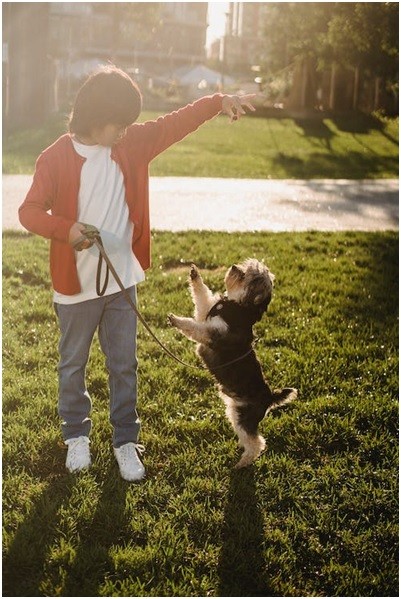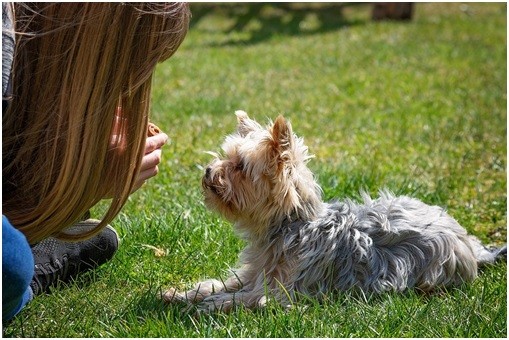Last Updated on May 10, 2025 by Pauline G. Carter
Getting a new dog is an exciting journey. It also comes with additional responsibilities of ensuring that you develop it into a well-behaved canine citizen.
Obedience training is an essential part of taking care of a dog. If you don’t train a dog properly, it could become aggressive and even dangerous to others. You might find it challenging to take it out in public.
Therefore, ensure you train your dog well before taking it out in public. You can teach some of the basic commands in your own house.
Many people ask, ‘What are the 7 basic commands for dog training?”. The answer to this question is what we will discuss in the post.
What Are The 7 Basic Commands For Dog Training?
You start with the seven basic commands in dog training: SIT, DOWN, STAY, COME, HEEL, LEAVE IT, AND NO.
Teaching your dog these seven basic commands is easy. That is why these commands are the first to train a dog.
Most dogs can easily pick up these commands and obey your orders. Some breeds, including Labrador Retriever, Dalmatian, Golden Retriever, and Border Collie, are intelligent and easy to train.

Let’s look at the seven basic dog training commands in detail.
Sit
The sit command is one of the most natural concepts for dogs. It is the easiest command for them to learn, and they will soon pick up the meaning of this command.
Even dogs new to training will get the hang of the sit command in a few sessions. It is also a command that dogs of any breed can pick up fast.
It is also a transition command. Once your dog learns the sit command, it can learn the other commands. This command will also help you make your dog sit calm at dinnertime and not create any chaos.
To teach this command, grab a treat and move it past your dog’s nose and forehead. At one point, your dog will look up and sit. It is when you must say ‘sit’ and repeat so that your dog understands what ‘sit’ means.
Down
Teaching the down or lay down command is also essential to dog training. It implies training your dog to move from sitting to lying on the floor.
It is helpful to use this command to avoid your dog jumping up on guests. It’s also the command to indicate your dog to go to bed where it should.
In addition, it takes longer for a dog to rush to the door when lying down. Therefore, it goes hand in hand with the stay command, which is the next command we will discuss.
To teach this command, show a treat to your dog and place your hand flat on the floor. Ultimately they will lie down to get the treat, which is when you need to give a click and give them the treat with lots of verbal praise.
Once it gets the hang of this command, you can practice without a treat. This command is also a great transition to tricks like rolling over or playing dead.
Stay
Teaching your dog the stay command will keep it from running to the road when it gets loose. It is also helpful for keeping your dog calm when a guest comes home. So it’s a vital command to teach your dog.
It is best to teach this command when your dog is hungry or tired, as it won’t get too hyper to focus. It can take anywhere between a few days to a few weeks for your dog to get the hang of this command, so you must be patient.
Get your dog to go into a sitting position. Hold your palm facing your dog and say, ‘stay.’ Once your dog obeys you and stays in place, reward it with a treat.
Repeat this while waiting longer before rewarding each time. Soon your dog will master this command.
Come
The come command is essential to teach your dog, especially if you want it to come to you on your call.
If you want to take your dog off-leash, this command is vital. It will help keep your dog safe when you go to the park or hike. It will also keep your dog safe in the street if it breaks off the leash.
It is essential to teach the stay command before the come command, making the process easier.
From the stay position, say your dog’s name and ‘come’ while holding a treat in your hand. When your dog comes running to you, say ‘come’ again and reward it with a treat.
Repeat this process until your dog responds well to the come command.
Heel
Teaching the heel command is essential to make your dog walk calmly by your side. That is why it is one of the basic commands for dog training.
It is handy when you exercise your pup in urban areas with little room on the sidewalk. It is even more vital to teach this command to large, strong dogs who tend to pull on the leash.
Dogs can easily be startled by loud vehicles on the street. Therefore the ability to ‘heel’ your dog will help them remain calm and out of danger. Once your dog learns the heel command, walking will be easier for both of you.
Say your dog’s name followed by ‘heel’ and move off with your hand tapping your side, indicating your dog to follow. Once it follows, you give it a treat, praise it, and repeat the process.
If your dog goes ahead of you, reverse the direction and follow the above process. Remember to give it a treat and praise.
Repeat this process until your dog has mastered the heel command.
Off
Teaching the off-command helps keep your dog from jumping on furniture or visitors. It is one of the most common dog issues. So, this command allows controlling your dog, who can’t keep its four paws on the floor.
The above behavior will continue if you don’t teach your dog this command. Although you may be okay with your dog displaying such behavior, it may not be the same with others. They may fear or decline your dog’s presence.
To teach this command, take a bottle filled with spare change. Shake the bottle when your dog jumps up. At this point, your dog will be startled and stop what it is doing.
It is when you need to say ‘off’ and reward your dog with a treat and a lot of praise.
No
Then no command is another essential command to teach your dog. Dogs are curious, so they might want to explore everything they see.
They typically use their mouths to explore the world. It could be dangerous, especially if your dog ingests a poisonous item, chicken bones, or chocolate.
‘No’ is a common term you can use to keep your dog from getting into such trouble. Say’ no’ if you see your dog doing something you don’t want it to do.
You can teach this command using dog-training discs. Place a treat on the floor, and rattle the discs when your dog is about to eat it. Remove the treat while you rattle the discs but say nothing. Let the sound do the work.
With repeat sessions, your dog will associate the sound with not getting a treat. Eventually, your dog won’t try to take the treat, anticipating the sound. Ultimately, it will give up looking disappointed.
Now is the best time to get them to perform another action, like ‘sit’ and reward it for obeying the command. It will make up for the previous disappointment.
Gradually, your dog will learn to associate actions with the discs as ‘fail’ and stop doing them. Eventually, you can stop using the discs and use the word ‘no.’
Why Is It Important To Know These Commands?
When you get a new puppy or adult dog, obedience training is vital to parenting. If you skip obedience training, it could lead to more problems with your dog in the future, which ultimately were preventable.
Also, teaching the basic commands as soon as you bring your new dog home will show him that you are in charge. It is essential to get this clear to your dog as dogs are pack animals and are known to follow the leader’s commands.

Dog Training Rules
Here are a few of the dog training rules to follow.
Keep training sessions short. Puppies can get bored and lose concentration quickly. So, try to fit in six five-minute daily sessions rather than one half-hour session at once.
Conduct training sessions only if you’re in a good mood. Dogs are very receptive to human emotions and can sense if you’re in a bad mood or stressed.
Always end training sessions in a triumphant mode. Keep an action that your dog can easily do, for the last, to ensure that you end on a successful note.
Always focus on reward-based training. Use a lot of treats, toys, and cuddles while training. You must avoid negative reinforcement, which includes punishing your dog.
Start training in a quiet environment and add distractions later. It helps your dog get used to a variety of surroundings.
Once your dog gets the hang of a command, swap food-based treats for toys. It will keep your dog from gaining weight.
An essential gear that you require in dog training is a collar. Ensure that you get a high-quality collar that is worth the investment you make for it.
A good collar will show excellent results in dog training.
If you are considering a dog collar for training, read “Halo 2+ Dog Collar Review: $999 for What? Scam or Worth it?.” It is a collar with amazing features that could be handy for training your dog.
What Are The Three D’s Of Dog Training?
The three D’s of dog training affects almost any behavior in dogs, and they are as follows:
Duration
It’s the length of time your dog maintains a behavior. For example, in commands like ‘sit’ and ‘down,’ the longer your dog has to hold it, the harder it becomes.
Distance
It’s how far away you are from your dog when it displays a particular behavior. The more the distance between you, the less your dog will rely on you. When you’re training distance, take it easy and slow.
Distraction
Distraction involves whatever is happening in the surroundings while training. You need to start with no distractions and gradually include them. When including distraction, start as far as possible and progressively decrease the distance.
When training, only work on one D at a time. Keep distractions for the last. Combine the Ds once your dog has mastered the command.
Final Thoughts
You must teach your dog these seven basic commands when it starts training. These commands are easy to pick up, and most breeds master them quickly.
Remember to reward your dog with treats and toys when it masters a command. Never use negative reinforcement, such as punishing your dog, as this could make it aggressive.
Frequently Asked Questions
What Is The Easiest Command For A Dog To Learn?
The sit command is the easiest for a dog to learn. Dogs can easily pick up this command and master it in no time.
What Are The Hardest Commands For A Dog To Learn?
The hardest commands for a dog to learn are waiting, go and fetch, play dead, back up, and tug.
How Many Commands Should You Teach A Dog At Once?
You need to teach your dog one command at a time. Once it masters the first command, move on to teaching the second.
What Is A Good Release Word For Dog Training?
Common released words for dog training are ‘break,’ ‘okay,’ and ‘free.’

